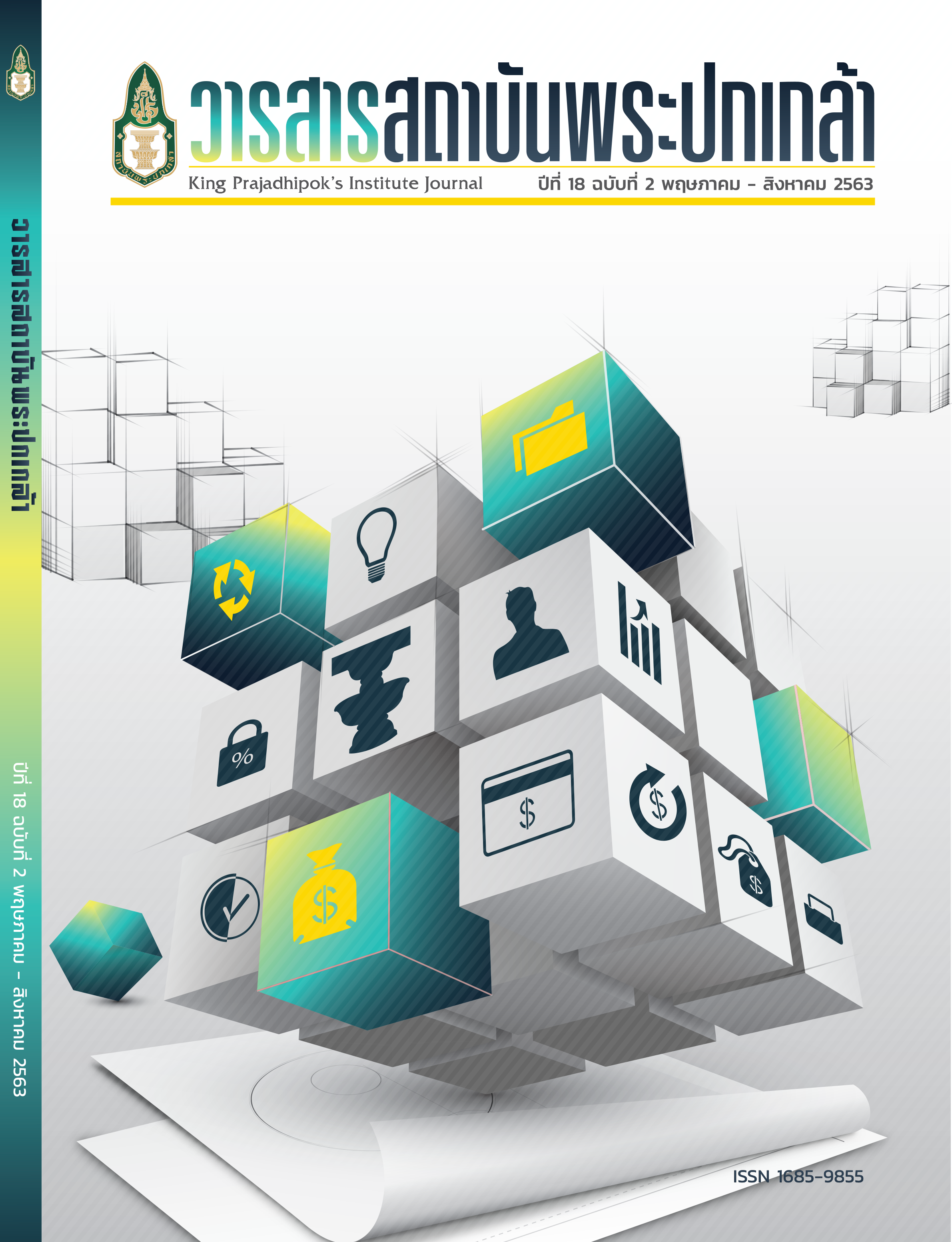Election Inspectors: Lessons Learned from Election Monitoring
Main Article Content
Abstract
The post of election inspector is a new election innovation proposed by the Constitution Drafting Commission to replace the Provincial Election Commission in monitoring officers and monitoring actions deemed to be fraudulent or violation of election laws. This article aims to study the lessons learned from the work of the provincial election inspectors, focusing on the general election on 24 March 2019 and present lessons learned from election monitoring along with appropriate recommendations for monitoring elections, Information was drawn from study of documentation, in-depth interviews with provincial election inspectors in each region and the author’s experience.
The results showed that provincial election inspectors were able to work independently but non-contributing team member, not precisely in the electoral law, role ambiguity, no result appear in their job of preventing electoral fraud, conflict with a coworker. If election inspectors came from outside their assigned provinces, they did not know the people in the area.
Provincial election Inspectors are important in election monitoring because their reports provide credible information for the Election Commission of Thailand to use when deciding to announce election results.Provincial election inspectors guarantee transparency and provide warning signals of actions deemed to be fraudulent or in violation of election law.
This paper suggests that the Election Inspectors must learn to contribute as team members, must possess knowledge and expertise in electoral laws, role clarity and materiality in monitoring, practice observation and skepticism, use reative conflict management, have competency to know the people in the area and provide fair performance appraisals.
Article Details
@ 2020 King Prajadhipok's Institute The Government Complex Commemorating All Right Reserved.
References
ปริญญา เทวานฤมิตรกุล. (2562, กันยายน 28). เปิดผลวิจัยเลือกตั้ง 24 มี.ค.ชี้ชัดระบบจัดสรรปันส่วนสร้างปัญหาสารพัด. สืบค้นจาก https://www.posttoday.com/politic/news/601868
ราชบัณฑิตยสถาน. (2546). พจนานุกรม ฉบับราชบัณฑิตยสถาน พ.ศ. 2542. กรุงเทพฯ: นานมีบุ๊คส์พับลิเคชั่นส์.
วัชราภรณ์ จุ้ยลำเพ็ญ. (2560, พฤษภาคม 30). การให้มีผู้ตรวจการเลือกตั้งแทนคณะกรรมการการเลือกตั้งประจำจังหวัด. สืบค้นจาก http://library2.parliament.go.th/Ebook/content-issue/2560/hi2560-029.pdf.
วิกิพีเดีย สารานุกรมเสรี. (2562, กันยายน 17). จังหวัดของประเทศไทยเรียงตามพื้นที่. สืบค้นจาก https://th.wikipedia.org/wiki/รายชื่อจังหวัดของประเทศไทยตามพื้นที่
สมคิด เลิศไพฑูรย์. (2547). คืนหมาหอน. ใน นรนิติ เศรษฐบุตร บรรณาธิการ, สารานุกรมการเมืองไทย (หน้า 69). กรุงเทพฯ: สำนักงานเลขาธิการสภาผู้แทนราษฎร.
สมชัย ศรีสุทธิยากร. (2561, พฤศจิกายน 20). ประสิทธิผลแห่งกลไกผู้ตรวจการเลือกตั้ง. มติชนสุดสัปดาห์. สืบค้นจาก http://www.matichon.weekly.com/column/article_126152
สมชัย ศรีสุทธิยากร. (2562). กกต. ม.44: เชิงอรรถการเมืองไทย พ.ศ. 2556-2561. กรุงเทพฯ: มูลนิธิเพื่อการศึกษาประชาธิปไตยและการพัฒนา (โครงการจัดพิมพ์คบไฟ).
สำนักงานคณะกรรมการการเลือกตั้ง. (2562). เอกสารสรุปประเด็นการประชุมถอดบทเรียนการจัดการเลือกตั้งสมาชิกสภาผู้แทนราษฎร เป็นการทั่วไป 24 มีนาคม 2562. นนทบุรี: สำนักงานคณะกรรมการการเลือกตั้ง.
สำนักงานคณะกรรมการการเลือกตั้ง. (2562). สรุปมติ กกต. กรณีมีข้อสังเกตเกี่ยวกับการสืบสวนหรือไต่สวนตาม ระเบียบ กกต. ว่าด้วย
การสืบสวน การไต่สวน และการวินิจฉัยชี้ขาด พ.ศ. 2562. นนทบุรี: สำนักงานคณะกรรมการการเลือกตั้ง.
Beach, Dale S. (1980). Personnel: The Management of People at Work. 4th ed. New York: Macmillan Press.
Beatty, C. A., & Gordon, J. R. M. (1988). Barriers to the Implementation of CAD/CAM Systems. Sloan Management Review, 29(4), 25-33.
Collins, Jim. (2001). Good to Great: Why Some Companies Make the Leap and Others Don’t. London: Harper Collins.
Daft, Richard L. (2010). Understanding the Theory and Design of Organizations. 10th ed. Illustrated. Boston: South-Western Cengage Learning.
Denzin, Norman Kent. (1978). The Research Act: A Theoretical Introduction to Sociological Methods. 2nd ed. New York: McGraw-Hill.
Dessler, Gary. (1986). Organization Theory: Integrating Structure and Behavior. Englewood Cliffs, New Jersey: Prentice-Hall. Inc.
Election Recruitment Division. (2018). Election Inspector’s Manual. Michigan: Ann Arbor city clerk’s office.
Fayol, Henri. (1949). General and Industrial Management. London: Sir Isaac Pitman & Sons.
Gareth, Jones R. (2001). Organizational Theory. 3rd ed. A Simon & Schuster Company Upper Saddle River, New Jersey: Prentice-Hall. Inc.
Goodman, Leo A. (1961). Snowball Sampling. The Annals of Mathematical Statistics, 32(1), 148-170.
Gordon, Judith R. (1999). Management and Organizational Behavior. Massachusett: Allyn & Bacon.
Herman, Nancy J. & Reynolds, Larry T. (1995). Symbolic Interaction: An Introduction to Social Psychology. 2nd ed. New York: General Hall, Inc.
Katz, Daniel & Kahn, Robert Louis. (1966). The Social Psychology of Organizations. 2nd ed. New York: John Wiley and Sons.
Kotter, John P. (2012). Leading Change. Massachusetts: Harvard Business Review Press.
Lofland, John. (2006). Analyzing Social Settings. 4th ed. Belmont, California: Wadsworth.
Luthans, Fred. (1992). Organizational Behavior. 6th ed. Singapore: McGraw-Hill International.
Malinowski, Bronislaw. (2014). Argonauts of the Western Pacific. London UK.: Routledge.
Marquardt, Mitchael J. (2011). Building the Learning Organization. 3rd ed. Boston: Nicholas Brealey International.
Maxwell, John C. (2004). Winning with People. Edinburgh: Nelson Books.
McClelland, David C. (1971). Testing for Competence Rather Than for Intelligence. New Jersey: Princeton.
Mintzberg, Henry. (1980, Mar). Structure in 5’s: A Synthesis of the Research on Organization Design. Management Science, 26(3), 322-341.
Monroe County Board of Elections. (2019). Training Manual for Poll Workers 2019. New York: Poll Worker Training Team.
Mooney, James D. & Reiley, Alan C. (1931). Onward Industry. New York: Harper and Row.
Nadler, Leonard. (1984). Handbook of Human Resource Development. 2nd ed. New York: John Wiley and Sons.
Nonaka, Ikujiro & Takeuchi, Hirotaka. (1995). The Knowledge-Creating Company. New York: Oxford University Press.
Overeem, P. (2005). The Value of the Dichotomy: Politics, Administration, and the Political Neutrality of Administrators. Administrative Theory & Praxis, 27(2), 311-329.
Rabinowitz, P. & Renault, V. (2013). Collaborative leadership : The Community Tool Box. Retrieved from http://ctb.ku.edu/en/tablecontent/subSection_main_1874.aspx
Robbins, Stephen P. (1989). Organizational Behavior: concepts, controversies and applications. 4th ed. Englewood Cliffs, New Jersey: Prentice-Hall. Inc.
Robbins, Stephen P. (1990). Organization Theory Structure Design and Applications. 3rd ed. Englewood
Cliffs, New Jersey: Prentice Hall Inc.
Robbins, Stephen P. (1994). Essentials of Organizational Behavior. 4th ed. Englewood Cliffs, New Jersey:
Prentice Hall Inc.
Spindler, George. (1974). Education and Cultural Process : Toward an Anthropology of Education. New York: Holt, Rinehart and Winston.
Szilagyi, Andrew D. Jr., & Wallace Marc J. Jr. (1990). Organizational Behavior and Performance. Glenview Illinois: Scott Foresman and company.
Werner, Jon M. & DeSimone, Randy L. (2011). Human Resource Development. 6th ed. Cincinnati: Cengage Learning.
Wisconsin Elections Commission. (2019). Election Inspectors. Retrieved from https://www.governmentjobs.com/jobs/2113210-0/seasonal-election-inspector/apply.
Wolcott, Harry F. (2009). Confessions of a Trained Observer. In Transforming Qualitative Data. 3rd ed. Thousand Oaks, California: SAGE.
Yukl, Gary A. (2012). Leadership in Organizations. 8th ed. New York: Pearson.


